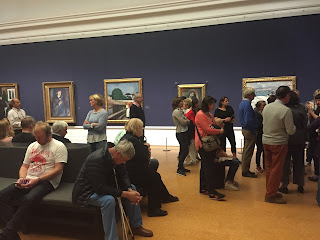Neil Denari at CED
Neil Denari reminded me of a jazz musician like Dave Brubeck, as I imagined him from the album covers, skirting the line between one genre and another while maintaining a businesslike demeanor. Attentive to details in a borderline obsessive way, he's also like Arata Isozaki (not quite so detail oriented) in the way he mines a particular formal move ("trope," as Denari put it) to the point of exhaustion.
His theme was the coexistence of the concrete and the mysterious. In one example, this came down to juxtaposing a white element with a curved, thin wood-covered, darker one. Most impressive of his built work was his ultra-luxe condo "tower" next to the High Line at W. 23rd St., which I saw without realizing it was his. It's very good, projecting out over the walkway without intruding on it, unlike any number of upmarket wonders nearby that make the High Line their feature in a "seen-and-be-seen" way.
Denair contrasted his work to "moral modernism" while discussing the High Line tower's graphic expression of structure. (The actual structure is set back behind the
façade.) Moral modernism would want to express its structure in reality, he said, defending not doing so in the name of
mystery. Later, he distinguished his work from parametric
exercises done for plutocrats. (I paraphrase.) Zaha Hadid was mentioned,
not favorably, yet he acknowledged that the High Line tower was also tipped
to the high end, with no need to value engineer. This led to an
explanation of the simplicity of a tower in China - using a single prefab
panel instead of the High Line's multiple panels, one of which was truly bespoke. ("Only he could do it," he said, referring to the structural engineer in Buenos Aires who fabricated a particulary beautiful opaque one.)
Denari showed a taller tower in Vancouver that's still under wraps and is chock full of micro-units that he also designed and furnished. It's different - Miesian but with notches that push the height and add corners and asymmetry. The tiny, highly transparent apartment reminded me of the Automat of my NYC youth: young people on display. (The critic Trevor Boddy wrote once that voyeruism is an issue in Vancouver, owing to the proximity of glass-enveloped towers.) Denari showed several projects in Asia, noting a current interest in "responsive icons" after a client in Taiwan called for "an icon" in its competition brief. Responsive as opposed to responsible, he added, but the real contrast appeared to be to towers like the Gherkin that really work for it.
Towers took up the last part of his talk and included an unrealized one (above) that reminded me of Minoru Takeyama's nightclub towers. I asked Denari about them and he recalled that one of them was on the cover of Charles Jenck's book on postmodernism. "I show it to my students to tell them, 'Who says you can't do an orange building?'" he said. Like the High Line tower, many of Denari's projects have graphic elements woven into them. "I also studied graphic design," he explained.
Denari showed a taller tower in Vancouver that's still under wraps and is chock full of micro-units that he also designed and furnished. It's different - Miesian but with notches that push the height and add corners and asymmetry. The tiny, highly transparent apartment reminded me of the Automat of my NYC youth: young people on display. (The critic Trevor Boddy wrote once that voyeruism is an issue in Vancouver, owing to the proximity of glass-enveloped towers.) Denari showed several projects in Asia, noting a current interest in "responsive icons" after a client in Taiwan called for "an icon" in its competition brief. Responsive as opposed to responsible, he added, but the real contrast appeared to be to towers like the Gherkin that really work for it.
Towers took up the last part of his talk and included an unrealized one (above) that reminded me of Minoru Takeyama's nightclub towers. I asked Denari about them and he recalled that one of them was on the cover of Charles Jenck's book on postmodernism. "I show it to my students to tell them, 'Who says you can't do an orange building?'" he said. Like the High Line tower, many of Denari's projects have graphic elements woven into them. "I also studied graphic design," he explained.




Comments
Post a Comment